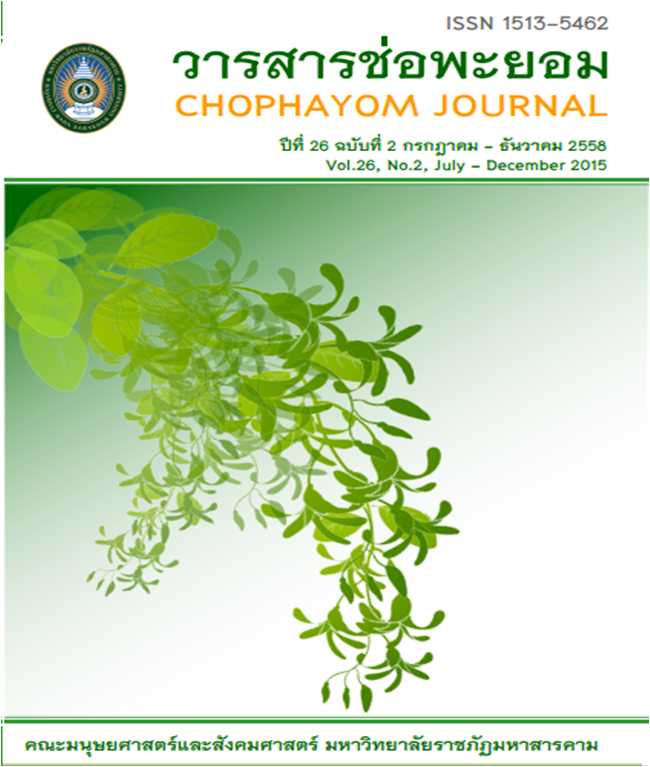ประสิทธิผลของการพัฒนาหมู่บ้านจัดการสุขภาพ ในชนบทจังหวัดมหาสารคาม Effectiveness of Health Management Village Development, in the Rural Areas of MahaSarakham Province
Abstract
บทคัดย่อ
การวิจัยเชิงวิเคราะห์แบบภาคตัดขวาง (Cross-sectional analytical research)ครั้งนี้มีวัตถุประสงค์ 1) เพื่อประเมินประสิทธิผล2) เพื่อระบุปัจจัยที่มีความสัมพันธ์กับประสิทธิผลของการพัฒนา3) เพื่อประเมินความแตกต่างของการประเมินตนเอง กับการประเมินจากภายนอกและ 4) เพื่อหาแนวทางในการพัฒนาหมู่บ้านจัดการสุขภาพ กลุ่มตัวอย่างคือหมู่บ้านจัดการสุขภาพจังหวัดมหาสารคาม จำนวน 360 หมู่บ้านจากประชากร 1,934 หมู่บ้าน คัดเลือกโดยการสุ่มตัวอย่างแบบเป็นระบบ เก็บรวบรวมข้อมูลโดยใช้แบบสัมภาษณ์แบบมีโครงสร้าง ทดสอบความเที่ยงมีค่าอัลฟ่าของครอนบาช เท่ากับ 0.81เก็บข้อมูลระหว่างสิงหาคม – ธันวาคม2555 วิเคราะห์ข้อมูลโดยใช้สถิติเชิงพรรณนา และสถิติเชิงอนุมาน ผลการศึกษา พบว่า การผ่านเกณฑ์หมู่บ้านจัดการสุขภาพ โดยการประเมินตนเองตามเกณฑ์ของกระทรวงสาธารณสุขซึ่งในประเมินรายด้านและรายข้อ มีหมู่บ้านผ่านเกณฑ์เกือบทุกหมู่บ้าน(ร้อยละ 93.85) ผู้วิจัยจึงกำหนดเกณฑ์ใหม่ของแต่ละตัวชี้วัดในแต่ละด้าน ซึ่งพบว่ามีหมู่บ้านผ่านเกณฑ์หมู่บ้านจัดการสุขภาพร้อยละ 49.49 ซึ่งลดลงร้อยละ 44.36โดยพบว่า 1) ด้านการมีส่วนร่วมในการจัดการสุขภาพของชุมชนผ่านเกณฑ์ร้อยละ 63.33 จากเดิมที่ผ่าน ร้อยละ 98.72 2) ด้านการจัดทำแผนด้านสุขภาพผ่านเกณฑ์ร้อยละ 51.79 จากเดิมที่ผ่าน ร้อยละ 97.44 3)ด้านการจัดการงบประมาณเพื่อใช้ในการพัฒนาสุขภาพ ผ่านเกณฑ์ร้อยละ 92.31จากเดิมที่ผ่าน ร้อยละ 100 4) ด้านการจัดกิจกรรมพัฒนาสุขภาพในหมู่บ้าน ผ่านเกณฑ์ร้อยละ 98.97 เท่าเดิม และ 5) ด้านการประเมินผลการจัดการด้านสุขภาพในหมู่บ้านผ่านเกณฑ์ร้อยละ 96.41เท่าเดิมปัจจัยที่มีความสัมพันธ์กับความสำเร็จในการพัฒนาหมู่บ้านจัดการสุขภาพ อย่างมีนัยสำคัญทางสถิติ ที่ระดับ 0.05 ได้แก่ การมีปราชญ์ชาวบ้าน (Adjusted OR = 1.20, 95% CI = 1.12 -1.93, p-value= 0.006) ความเชี่ยวชาญพิเศษของชุมชน (Adjusted OR = 3.82, 95% CI = 2.11-6.90, p-value<0.001) ชุมชนมีศักยภาพในการพัฒนาที่ผ่านมา (Adjusted OR = 2.30, 95% CI = 1.16-4.57, p-value=0.017) ความเข้มแข็งของผู้นำระดับสูง (Adjusted OR = 6.10, 95% CI = 2.18-17.08, p-value= 0.001) การจัดหางบประมาณเพื่อพัฒนาหมู่บ้านจัดการสุขภาพจากแหล่งอื่นนอกเหนือจากกระทรวงสาธารณสุข (Adjusted OR = 2.87, 95% CI = 1.01-7.87, p-value=0.047) การมีส่วนร่วมของการพัฒนาชุมชนและการกำหนดนโยบายสาธารณะของประชาชนระดับปานกลาง และสูง(Adjusted OR = 2.75, 95% CI = 1.02-7.34, p-value=0.044 และAdjusted OR = 1.47, 95% CI = 0.42-5.14, p-value=0.044)ตามลำดับ ปัญหาในการพัฒนาหมู่บ้านจัดการสุขภาพได้แก่ การขาดการมีส่วนร่วมของประชาชนและกลุ่มองค์กรในชุมชนไม่มีศักยภาพในการดำเนินการจัดทำแผนและดำเนินการตามแผน ผู้นำไม่มีศักยภาพในการนำชุมชนการสื่อสารไม่มีประสิทธิภาพ แนวทางในการพัฒนาหมู่บ้านจัดการสุขภาพให้มีคุณภาพมากขึ้น ประกอบด้วย 3 ยุทธศาสตร์ คือ 1)การพัฒนาศักยภาพ/สมรรถนะของแกนนำชุมชนและเจ้าหน้าที่ในการวางแผนการพัฒนาชุมชน2)การสร้างความเข้มแข็งภาวะผู้นำ และการสื่อสารเพื่อส่งเสริมความร่วมมือเพื่อพัฒนาหมู่บ้านจัดการสุขภาพและ3)การพัฒนาศักยภาพชุมชน/แกนนำชุมชนในการดำเนินกิจกรรมสุขภาพของชุมชน
คำสำคัญ:ประสิทธิผลของการพัฒนา, หมู่บ้านจัดการสุขภาพ
ABSTRACT
This cross sectional analytical study aimed 1) to assess the effectiveness 2) to identify factors associated 3) to identify the different between the self-assessment based on the Ministry of Public Health (MoPH) and by outsider (researcher) 4) to identify strategies to help developing the quality of health management village development. The total of 360 villages was systematic randomly selected from the population of 1934 villages in all districts in MahaSarakham Province. The data was collected between August and December 2012, using structured questionnaire interview developed by the researcher had high reliability with the Cronbach’s alpha coefficient of 0.81. Both descriptive and inferential statistics were applied for data analysis. The results indicated that from self-assessment, 93.85 % of the villages passed overall criteria of the MoPH. However, when using this research criteria, only 49.49 passed the criteria as ahealth management village, a 44.36 % reduction. Considering passing the criteria on each domain of health management village, 1) 63.33 % passed the criteria on participation for health management village development from the previous 98.72 % that passed the MoPH criteria, 2) 51.79 % for developing health plan from the previous 97.44%, 3) 92.31% passed the budget criteria from the previous 100% (all villages passed), 4) 98.97 % passed on the health activities, no changes on the numbers of the villages that passed both criteria and 5) 96.41%, no changes, on the evaluation process of health management village.Factors influencing the development of health management village were having local wisdom (Adjusted OR = 1.20, 95% CI = 1.12 -1.93,p-value= 0.006), community having special competency (Adjusted OR = 3.82, 95% CI= 2.11-6.90 ,p-value<0.001),existing capacity in village development (Adjusted OR = 2.30, 95% CI = 1.16-4.57 ,p-value=0.017) high level of leadership(Adjusted OR = 6.10, 95% CI = 2.18-17.08, p-value= 0.001), able to get budget from other sources ( not only from the MoPH) (Adjusted OR = 2.87, 95% CI = 1.01-7.87 ,p-value=0.047) people participation in village development and public policy development at medium to high levels (Adjusted OR = 2.75, 95% CI = 1.02-7.34, p-value= 0.044 และ Adjusted OR = 1.47, 95% CI = 0.42-5.14, p-value=0.044) accordingly.Problems the villages faced in health management were lack of participation of the villagers and groups, lacked of capacity in developing health plan and implementation, poor leaderships and inefficient communication.Strategies suggested to improve the health management capacity of the villages were 1) capacity and competency building of village leader, and health personal. 2)leadership development and communication skills 3) capacity building for health activities implementation.
Keyword: Effectiveness of Development, Health Management Village



